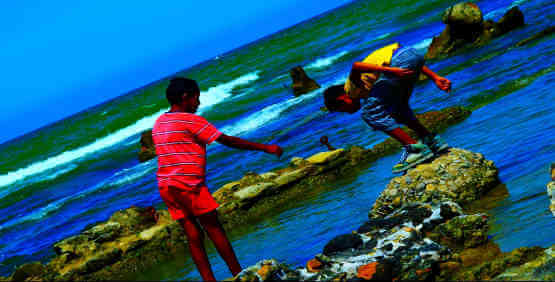Jean-Luc Godard’s “The Image Book” is a demonstration of thinking through and about images and sounds that makes most other films now playing New York look awfully basic. A much condensed follow-up to Godard’s four-hour “Histoire(s) du Cinéma,” it shows the uselessness of labels like “documentary,” “avant-garde film,” and “essay-film” or even “post-cinema,” when faced with something that spans all four.
Taken largely from clips of other films (including many of Godard’s own), “The Image Book” has a five-part structure. Two of its five parts are upfront about their subject matter while the rest is more allusive: “Those Flowers Between the Rails, In the Confused Winds of Travels” concentrates on cinema’s depiction of trains, while the closing “La Région Centrale,” which takes up more than a third of the film, tries to address the ways in which American and Europeans have stereotyped and demonized Arabs, mostly but not entirely through movies, and how Arabs themselves have depicted each other.
One of Godard’s most influential trademark aphorisms is “the best way to criticize a film is making one.” He began speaking about the death of cinema in the ‘80s; some of his films of that decade, like “Passion” and “Rise and Fall of a Small Cinema Company,” are obsessed with that subject. And while “The Image Book” itself (and the fact that Americans are getting a chance to see it in theaters) shows that movies haven’t died, it’s a terminal reckoning with cinema that places old favorites like Nicholas Ray’s “Johnny Guitar” and Robert Aldrich’s “Kiss Me Deadly” in a montage next to news footage from Al Jazeera and Michael Bay clips. Godard deliberately chose visually degraded excerpts of the movies he uses. While he could’ve gotten much higher-quality copies, most look like fourth-generation VHS dubs. Further, he alters them with bleaching or color saturation to change the images even further.
But the most innovative aspect of “The Image Book” is its sound. Godard delivers a voice-over for much of it, sometimes with other voices overdubbed simultaneously, jostling with each other at lesser volume. The voices pan from speaker to speaker. Sometimes, Godard speaks at a low but clearly audible level, suddenly making one realize how lazy the convention of loud documentary voice-overs is. The sound design evokes everything from dub reggae to ASMR videos.
“The Image Book” is genuinely provocative at its most ambiguous. A ghostly reflection of the cattle cars that brought Holocaust victims to concentration camps is present in the film’s many images of trains, but this feels like a distant rhyme. Godard has used both on-screen text and literary quotations since the ‘60s — his 1990 film “Nouvelle Vague” was based on a script whose every line is a quote from a novel — but even after two viewings, I don’t know exactly what the title “The Image Book” means. I do suspect that Godard distrusts the way images have supplanted words while recognizing the extent to which his own work has contributed to this and his own aesthetic, including here, plays it out.
Still, “La Région Centrale” engages in a very explicit political critique. On the soundtrack, Godard says “There is no doubt that the act of representation almost always involves violence toward the subject of representation.” Here, that means Arabs. He temporarily passes over the voice-over to the late Algerian scholar Noureddine Aba, and later tells a fictional narrative taken from a novel by French-Egyptian writer Albert Cossery, set in the imaginary emirate of Dofa. But when the politics of “The Image Book” get more specific, the fact that it’s built from brief quotes from unidentified sources (the credits do list all of them, which is rare for Godard, but they flash by very quickly) means that it muddles the issue of representation that it brings up. Images of real and fictional violence, made by Americans, Europeans, and Middle Easterners, get jumbled together.
Further, as well-intentioned as Godard is, he speaks about and depicts Arabs as if they only live in the Middle East: unless I missed something (which is quite possible), there are no images of Arabs in Europe here. Additionally, I only know about the references to Aba and Cossery through reading a review by critic Michael Sicinski. While watching “The Image Book” the first time, I had no idea where the Dofa narrative came from and thought Godard was probably quoting Arab-American scholar Edward Said for most of this section. Of course, Godard obviously wants an active spectator who’d research this film’s references after seeing it, but one would benefit from understanding them while watching “The Image Book” when it’s aiming for something beyond an elliptical montage of old movies.
Even in its flaws, “The Image Book” cuts deeply to what it feels like to live in 2019. At its weakest, it suffers from a soundbite sensibility. While I recognized most of its film clips, trying to make connections between them reproduces the feeling of seeing tweets that allude vaguely or sarcastically to an op-ed or news event and feeling lost in a world where context has vanished. Godard saw this media landscape and the dizzying mental state it inspires coming long before most filmmakers — or just most people — did. Like most major art, “The Image Book” is greater than the sum of its parts. It’s also deeply mysterious: anyone who claims mastery over it after one viewing is lying.
THE IMAGE BOOK | Directed by Jean-Luc Godard | In English and French, Arabic, and Italian with English subtitles | Kino Lorber | Opens Jan. 25 | IFC Center, 323 Sixth Ave. at W. Third St., ifccenter.com; Film Society of Lincoln Center, 144-165 W. 65th St., filmlinc.org



































